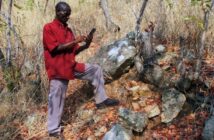The Paris Agreement represents an unprecedented collaboration among nations who choose to work together to address climate change in their own countries and globally. Dr. Jane Goodall participated in the 21st Conference of the Parties to the Treaty on Climate Change in Paris and, at that time, she called on each of us to take action ourselves to protect our natural world. Amidst all of the evidence and already occurring changes, threatening all living things in the oceans and on land (including humans), the Trump Administration is set on withdrawing from the Paris Agreement. In response to this, we must use Jane’s message of action as a beacon to call upon ourselves and others to make decisions to help in curtailing climate change – an agreement we all make with the planet and all the other creatures we share this world with to protect life.
Climate Change is Real
The climate is changing, and not in a subtle or “cyclical” way. According to an Intergovernmental Panel on Climate, predictions for accelerated climate change indicate that average global temperatures could increase between 1.4 and 5.8 degrees Celsius by the year 2100 (IPCC). Though that may seem “small,” the reality of this is several fold – causing alterations to global and smaller ecosystems varying between drought and flooding, increased frequency and intensity of storms, desertification, species migrations and extinctions, and reduced agricultural yield, just to name a few. Additionally, environmental refugees, scarcity, famine and conflict are sure to increase as these conditions do, and the economic losses due to climate change are massive, costing the global economy $700 billion annually by 2030 (Business Insider). The “greenhouse effect” is the main culprit, as the burning of fossil fuels like oil and coal increases the concentration of carbon dioxide in the atmosphere, trapping heat (NASA). We must reduce emissions and protect natural areas which sequester (trap) carbon, in order to prevent further and catastrophic warming.
The Paris Agreement
The Paris Agreement, established in 2015, enlisted all of the nations in the world, (with the exception of Syria and Nicaragua – who felt it was not “tough enough”) to pledge to reduce greenhouse gas emissions in an attempt to slow the consequences of increasing global temperature. Within the initial agreement, the United States committed to reducing carbon emissions by 26-28% within 10 years (White House Archives). A withdrawal from these commitments would not only endanger billions of lives, but will also portray the United States as detrimental to the progress and safety of international communities, environments and species.
“It would also devastate our international credibility. We are one of the two largest carbon emitters, with China. We are the ones who put this deal together. It is the first step to try to do something about climate change. For President Trump to take us out, it is anti-science.” – Nick Burns, former Under Secretary under the George W. Bush administration (CNN)
What Now?
Following massive movements like the March for Science and the People’s Climate March to underscore the necessity and integrity of science and science backed policy, we are even more aware how crucial it is to become informed about this enormous issue and to make it a priority in our planning, decisions, and policy as an international community. The Jane Goodall Institute has committed to protect forests and thereby ensure that stored CO2 is kept out of the atmosphere and that the trees can continue to absorb more. By protecting these habitats and biodiversity we can make sure these ecosystems remain healthy and ensure the long term survival of these forests.
We also work with local communities around conservation areas to create land use plans and determine how to best preserve forest, create forest reserves and build sustainable livelihoods. JGI has also been working with a REDD+ grant in Tanzania which allows heavy C02 polluters to offset their emissions by paying governments and villagers in developing countries not to cut down their forests, along with our forest monitoring project which is run by local citizens. These endeavors alongside our youth environmental compassionate leadership program Roots & Shoots in nearly 100 countries and our public outreach using Dr. Goodall’s voice (follow Dr. Goodall and the Jane Goodall Institute on Facebook, Twitter and Instagram) and our networks to increase awareness and grow a community of people inspired by hope to act, are ways in which we are addressing climate change and interconnected issues facing people, animals and the environment, every day. Through a combination of individual action, our programs, and propelling movements demonstrating to policymakers that we will not accept apathy, we can change our behavior and better protect the balance of life on earth.
We Are Hope in Action
As the United States steps away from its commitments under the Paris Agreement and cedes its leadership role to other countries, we renew Dr. Goodall’s call for individual action. We see the power of individual action every day as people connect with one another and begin to drive real change. We see the power of this action as corporations make climate-responsible decisions that are both demanded by their customers and by their bottom lines. We see the power of you. Please join us to make our own climate agreements, to take action to make the world a better place for people, animals and the environment. Together, we will prevail.






